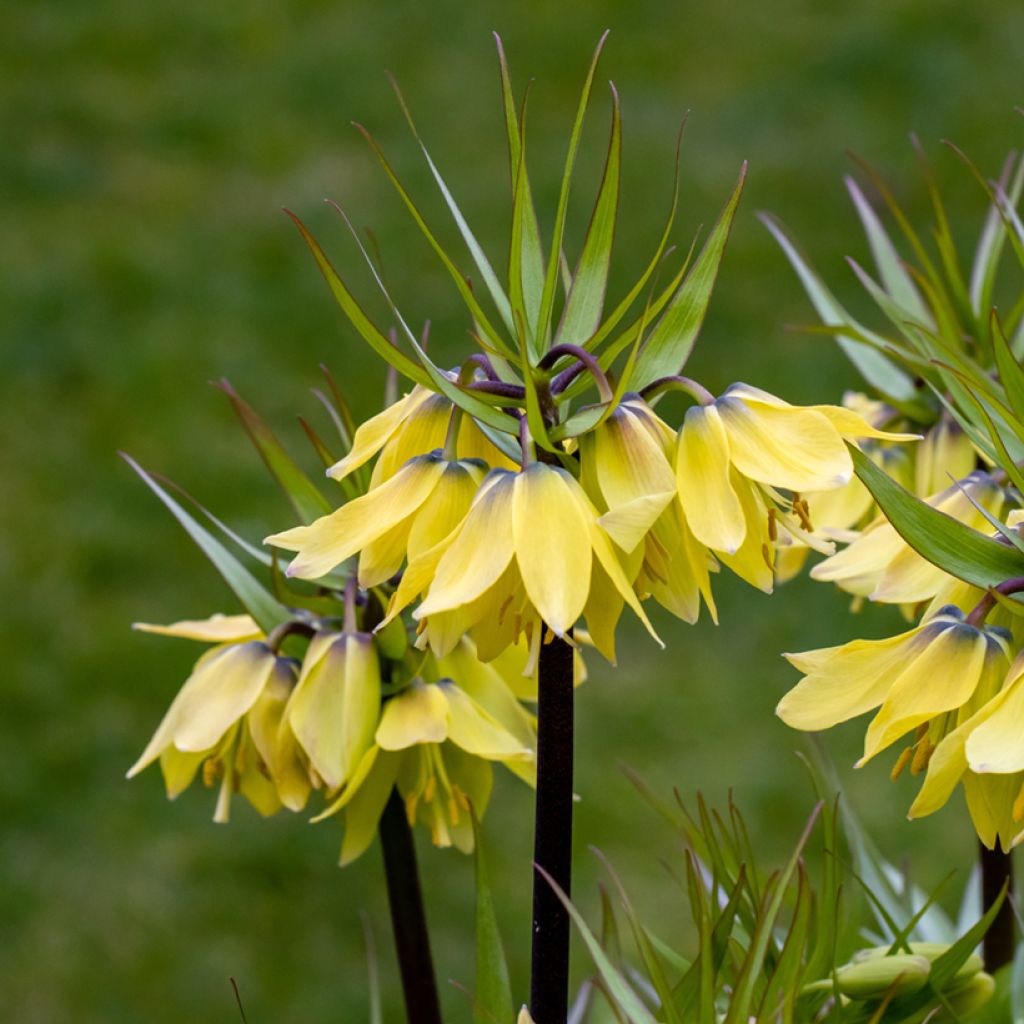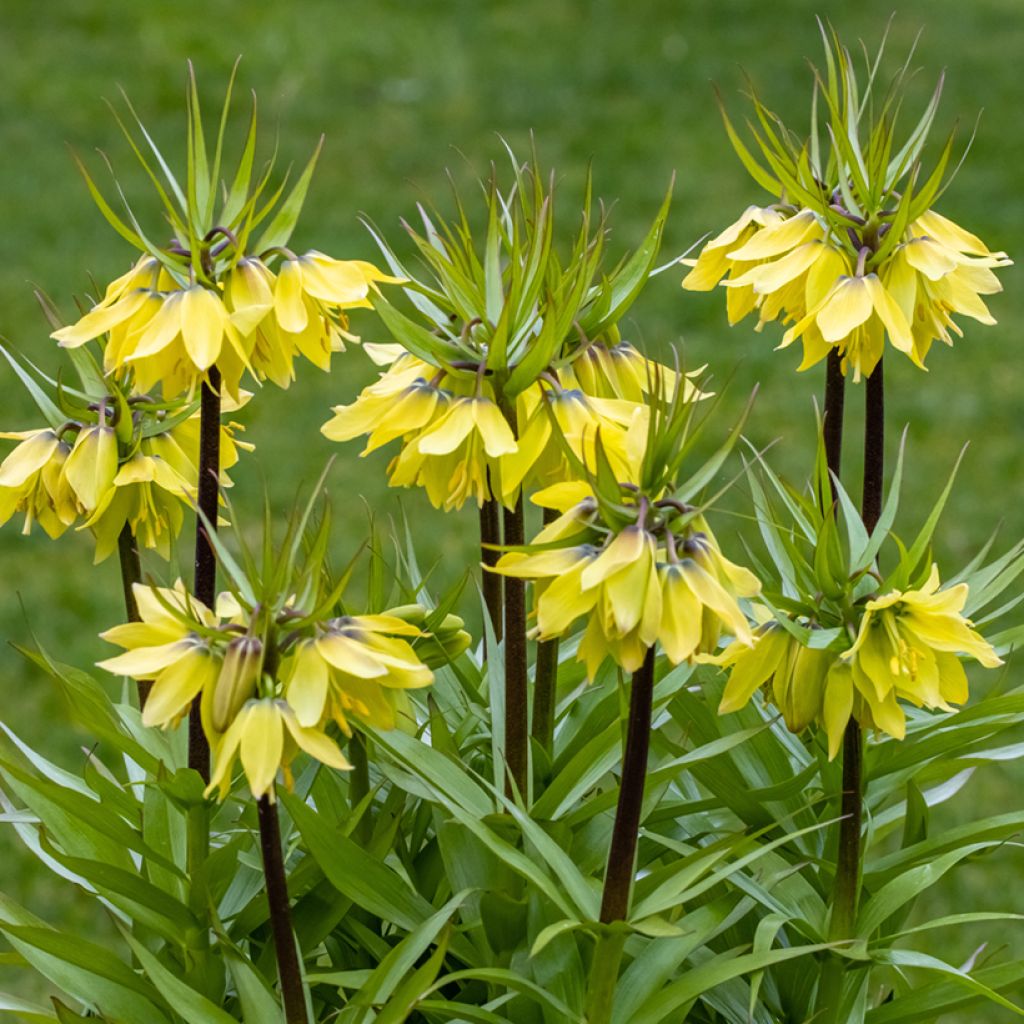

Fritillaria 'Early Sensation'


Fritillaria 'Early Sensation'
Fritillaria 'Early Sensation'
Fritillaria imperialis Early Sensation (Early series)
Crown Imperial, Imperial Fritillary
This plant carries a 6 months recovery warranty
More information
We guarantee the quality of our plants for a full growing cycle, and will replace at our expense any plant that fails to recover under normal climatic and planting conditions.
From €5.90 for pickup delivery and €6.90 for home delivery
Express home delivery from €8.90.
Does this plant fit my garden?
Set up your Plantfit profile →
Description
Fritillaria 'Early Sensation' is a very beautiful early variety of crown imperial that offers fresh flowers in March and April, with a yellow-green chartreuse colour. The tall and proud floral stem reaches a height of 1m and carries a crown of large campanulate flowers, topped with a beautiful tuft of green leaves. This imposing bulb always makes an impression in sunny flower beds. With a strong personality, it finds a place in a contemporary or exotic setting, alongside narcissus or tulips, in a harmonious colour scheme.
The Imperial Fritillary belongs to the lily family. This species is very cold-resistant, in well-drained soil, and originates from eastern Turkey, northern Iraq and Iran, and is widespread up to Afghanistan and Pakistan. It is a perennial herbaceous plant with a large scaly bulb, whose vegetation emerges from the ground in late winter and disappears after flowering. The 'Early Sensation' cultivar reaches a height of about 90cm to 1m when in bloom. The green stem is tinged with reddish-brown in its upper half and only carries leaves in its lower half. They are narrow and pointed, shiny green, about 12cm long and arranged in whorls. They somewhat resemble lily leaves. The plant emits an odour that may be unpleasant. Flowering takes place in March-April, at the top of the stem. It takes the form of a crown composed of 6 to 20 pendant bell-shaped flowers, measuring 6cm in diameter.
The Imperial Fritillaries are surprising and their atypical silhouette is eye-catching. Use them to add height to your flower beds or to fill a rock garden. Grow them in pots to enjoy them on your terrace. The toxic bulb emits an unpleasant odour that repels rodents, but this odour is not perceptible once the bulb is buried. Crown Imperials are often planted among carpets of tulips, narcissus, or muscari, from which their tall floral stems proudly emerge. Combine 'Early Sensation' with plants with decorative foliage such as lady's mantle or fennel, which harmonise well with its chartreuse colour. The fritillary occupies a prominent place in floral compositions immortalised by the great Flemish masters such as Jan Brueghel the Elder.
In the past, the crown imperial was called "tears of Mary." Its Persian name means "the flower that weeps" because the fritillary has large nectaries in the centre of its petals that produce large drops of nectar.
Report an error about the product description
Plant habit
Flowering
Foliage
Botanical data
Fritillaria
imperialis
Early Sensation (Early series)
Liliaceae
Crown Imperial, Imperial Fritillary
Cultivar or hybrid
Planting and care
Fritillaria Early Sensation thrives in full sun. It needs light but not necessarily direct sunlight. It thrives best in a continental climate where winters and summers are dry and springs are humid. Plant it in a fertile, light, loose, and well-drained soil. Avoid heavy soil as it may lead to the appearance of fungi. If the drainage is insufficient, the fritillary may rot. Plant it from late August to September to October by adding sand, gravel, or pumice to the hole. Place the bulb at a depth of 20 cm. In winter, we recommend mulching the fritillary to protect it from moisture. Remove faded flowers if you do not want them to self-seed. Do not water your fritillaries in summer and winter. If the soil is too dry in spring, lightly water to start the bulb, but without excess.
Planting period
Intended location
Care
This item has not been reviewed yet - be the first to leave a review about it.
Haven't found what you were looking for?
Hardiness is the lowest winter temperature a plant can endure without suffering serious damage or even dying. However, hardiness is affected by location (a sheltered area, such as a patio), protection (winter cover) and soil type (hardiness is improved by well-drained soil).

Photo Sharing Terms & Conditions
In order to encourage gardeners to interact and share their experiences, Promesse de fleurs offers various media enabling content to be uploaded onto its Site - in particular via the ‘Photo sharing’ module.
The User agrees to refrain from:
- Posting any content that is illegal, prejudicial, insulting, racist, inciteful to hatred, revisionist, contrary to public decency, that infringes on privacy or on the privacy rights of third parties, in particular the publicity rights of persons and goods, intellectual property rights, or the right to privacy.
- Submitting content on behalf of a third party;
- Impersonate the identity of a third party and/or publish any personal information about a third party;
In general, the User undertakes to refrain from any unethical behaviour.
All Content (in particular text, comments, files, images, photos, videos, creative works, etc.), which may be subject to property or intellectual property rights, image or other private rights, shall remain the property of the User, subject to the limited rights granted by the terms of the licence granted by Promesse de fleurs as stated below. Users are at liberty to publish or not to publish such Content on the Site, notably via the ‘Photo Sharing’ facility, and accept that this Content shall be made public and freely accessible, notably on the Internet.
Users further acknowledge, undertake to have ,and guarantee that they hold all necessary rights and permissions to publish such material on the Site, in particular with regard to the legislation in force pertaining to any privacy, property, intellectual property, image, or contractual rights, or rights of any other nature. By publishing such Content on the Site, Users acknowledge accepting full liability as publishers of the Content within the meaning of the law, and grant Promesse de fleurs, free of charge, an inclusive, worldwide licence for the said Content for the entire duration of its publication, including all reproduction, representation, up/downloading, displaying, performing, transmission, and storage rights.
Users also grant permission for their name to be linked to the Content and accept that this link may not always be made available.
By engaging in posting material, Users consent to their Content becoming automatically accessible on the Internet, in particular on other sites and/or blogs and/or web pages of the Promesse de fleurs site, including in particular social pages and the Promesse de fleurs catalogue.
Users may secure the removal of entrusted content free of charge by issuing a simple request via our contact form.
The flowering period indicated on our website applies to countries and regions located in USDA zone 8 (France, the United Kingdom, Ireland, the Netherlands, etc.)
It will vary according to where you live:
- In zones 9 to 10 (Italy, Spain, Greece, etc.), flowering will occur about 2 to 4 weeks earlier.
- In zones 6 to 7 (Germany, Poland, Slovenia, and lower mountainous regions), flowering will be delayed by 2 to 3 weeks.
- In zone 5 (Central Europe, Scandinavia), blooming will be delayed by 3 to 5 weeks.
In temperate climates, pruning of spring-flowering shrubs (forsythia, spireas, etc.) should be done just after flowering.
Pruning of summer-flowering shrubs (Indian Lilac, Perovskia, etc.) can be done in winter or spring.
In cold regions as well as with frost-sensitive plants, avoid pruning too early when severe frosts may still occur.
The planting period indicated on our website applies to countries and regions located in USDA zone 8 (France, United Kingdom, Ireland, Netherlands).
It will vary according to where you live:
- In Mediterranean zones (Marseille, Madrid, Milan, etc.), autumn and winter are the best planting periods.
- In continental zones (Strasbourg, Munich, Vienna, etc.), delay planting by 2 to 3 weeks in spring and bring it forward by 2 to 4 weeks in autumn.
- In mountainous regions (the Alps, Pyrenees, Carpathians, etc.), it is best to plant in late spring (May-June) or late summer (August-September).
The harvesting period indicated on our website applies to countries and regions in USDA zone 8 (France, England, Ireland, the Netherlands).
In colder areas (Scandinavia, Poland, Austria...) fruit and vegetable harvests are likely to be delayed by 3-4 weeks.
In warmer areas (Italy, Spain, Greece, etc.), harvesting will probably take place earlier, depending on weather conditions.
The sowing periods indicated on our website apply to countries and regions within USDA Zone 8 (France, UK, Ireland, Netherlands).
In colder areas (Scandinavia, Poland, Austria...), delay any outdoor sowing by 3-4 weeks, or sow under glass.
In warmer climes (Italy, Spain, Greece, etc.), bring outdoor sowing forward by a few weeks.



































